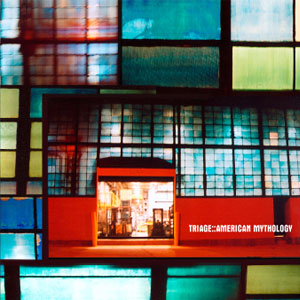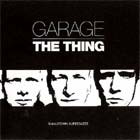Home » Jazz Articles » Multiple Reviews » Sonore; Ken Vandermark; The Thing
Sonore; Ken Vandermark; The Thing
 Sonore
Sonore No One Ever Works Alone
Okka Disk
2004
When the saxophone trio Sonore played Tonic last month, the moods evoked included a honky-tonk blues bar, a foggy Holmes-ian London complete with murdered prostitute and a pit filled with the screaming damned souls of hell.
Their album, removed as it is from the live performance and hyperbolic description, is less visceral, more cerebral but still a successful entry into the trepiditous realm of the all-saxophone group.
Texturally, multi-instrumentalists help the cause— No One Ever Works Alone has 24 possible saxophone combinations multiplied by Peter Brötzmann's indefatigability, Mats Gustafsson's percussive brilliance and Ken Vandermark's synthesis of the entire saxophone tradition. These three form the core of Brötzmann's Chicago Tentet, a marvelous large ensemble, and that vigor has been compacted here.
Much like the performance, this is difficult music to listen to, lacking as it does any chordal center or melodic base. However, the players seem to understand this and work the improvisations to include distinct solo sections supported by whatever comping is in a free jazz context.
Another positive is that even though all three saxophonists are accomplished squawkers, they thankfully understand that no one wants to hear an hour of that and work assiduously to create structure, with atonality a flourish rather than a foundation. Make special note of how effectively the trio varies the intensity of the music throughout, creating lovely quiet passages amidst the cacophony and its ability to end distinctly, a bane of most improvised music.
Sonore is an example of how "free jazz", music that has no repertoire, no standards, relies on the head-on collision of different musical perspectives. Vandermark and Gustafsson here are quite different than on two projects released on the Oslo-based Smalltown Superjazz label.
![]() Ken Vandermark/Paal Nilssen-Love
Ken Vandermark/Paal Nilssen-Love
Dual Pleasure 2
Smalltown Superjazz
2004
Dual Pleasure 2 is the ambitious follow-up to Vandermark and Norwegian drummer Paal Nilssen-Love's first duo from last year. A wonderful two-disc set (one studio, one live), it gives full range to the abilities of two visionary musicians. Though the results are quite different, the collaboration is as special as the work of Evan Parker and Paul Lytton.
Continuing the sax-drum duet tradition that has become de rigueur in improvised music, the abstract nature of the two musicians is what stands out. Vandermark, who may be the most compelling conceptualist since Eric Dolphy, is well matched against the fortitude of Nilssen-Love, who confounds the idea of rhythm and form without sacrificing intuition. The playing sounds more unified and thoroughly envisioned than much written music.
The studio portion is a heady mélange of styles: earthy Interstellar Space-inspired pieces like "Train Hits the Station" or "Never Leave Well Enough Alone"; the Lacy-esque "Nice and Dry" with Vandermark on Bb clarinet; moody figuratives such as "Finish Wood" (a lovely bass clarinet and brushed drum feature) and "Living Kills".
If the studio cuts impress with their texture and reserve, the live session from September 2003 in Oslo is the more primeval portion. Vandermark's lines are sharper and edgier, his marvelous tone skirting some rough patches. Nilssen-Love, who fascinated with his hushed approach in the studio, gets to apply his percussive intellect in a more insistent and frenzied fashion here. The album is two long cuts, "Stray Dog" and "Double Weight" and one shorter coda, "As It Goes". Though volume may have replaced subtlety and energy switched for introspection, the cohesion is still there—a testament to musicians not shackled to one particular approach.
 The Thing
The Thing
Garage
Smalltown Superjazz
2004
Coming after the sax trio and the sax-drum duo, The Thing (Gustafsson on tenor and baritone, Nilssen-Love and fellow Norwegian Ingebrigt Flaten on bass) is a jolt. The concept behind this album is progressive renditions of modern and classic garage music, with two originals and a Brötzmann "composition" thrown in for good measure. Here the currency is sheer power and the simple forms allow Gustafsson to bellow, Nilssen-Love to bash and Flaten to pluck feverishly.
Garage music appeals to listeners for its lack of pretension and catchy repetitive forms. The Thing uses this formula but inserts atonality; with more energy than most can muster, they subvert the forms and flail away with punk-like abandon. When this group played at the Oslo Jazz Festival this summer, they presented two short sets, delicate like a nail-studded two-by-four bludgeoned against your skull.
Even if the material is unfamiliar, the fervency that the trio brings to the music is infectious. It has rhythm and bounce and is actually fun for fun's sake. Music by such groups as the Yeah Yeah Yeahs and the White Stripes, both covered here, has proved to be immensely popular. The Thing's Garage is an artistic statement that triples as an examination of their roots (like early free jazz sabotages of hard bop) and proof that jazz can be emotional and rousing when put in the right hands. The right exposure could make this project a cross-genre success story, lending legitimacy to garage and teenage fans to free jazz.
No One Ever Works Alone
Tracks: 1. Elements Of Refusal (10:50); 2. Trees After A Fire (13:16); 3. Broken Hymn (10:30); 4. Death Can Only Kill Me Once (14:51); 5. Hammer Requiem (6:02); 6. Blessed Assurance, Uninsured (8:42); 7. No One Ever Works Alone (2:46). Total Time: 66:59.
Personnel: Mats Gustafsson: tenor and baritone saxophone; Ken Vandermark: B-flat clarinet, tenor and baritone saxophone; Peter Brötzmann: A-clarinet/tarogato, alto, tenor, and bass saxophone.
Dual Pleasure 2
Tracks: Disc 1: 1. Train Hits The Station; 2. Finish Wood; 3. Look Left; 4. Never Leave Well Enough Alone; 5. Nice & Dry; 6. Short Terminal; 7. Non Chilled; 8. Living Kills; 9. There Is Nothing Left To Break. Disc 2: 1. Stray Dog; 2. Double Weight; 3. As It Goes.
Personnel: Ken Vandermark: Reeds; Paal Nilssen-Love: Drums.
Garage
Tracks: Art Star; Aluminum; Haunted; Eine Kleine Marschmusik; Hey Fläsk (for Alva Melin and Martin Revheim); Have Love Will Travel; Garage.
Personnel: Mats Gustafsson: Baritone, Tenor Sax; Ingebrigt Flaten: Bass; Paal Nilssen-Love: Drums.
< Previous
Happy Birthday Newport: 50 Swinging Y...
Comments
Tags
For the Love of Jazz
 All About Jazz has been a pillar of jazz since 1995, championing it as an art form and, more importantly, supporting the musicians who create it. Our enduring commitment has made "AAJ" one of the most culturally important websites of its kind, read by hundreds of thousands of fans, musicians and industry figures every month.
All About Jazz has been a pillar of jazz since 1995, championing it as an art form and, more importantly, supporting the musicians who create it. Our enduring commitment has made "AAJ" one of the most culturally important websites of its kind, read by hundreds of thousands of fans, musicians and industry figures every month.



















